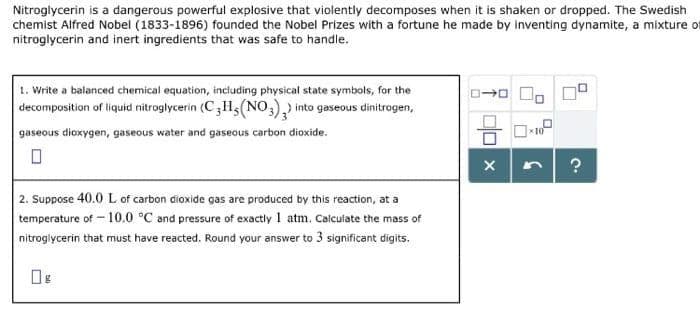1. Write a balanced chemical equation, including physical state symbols, for the decomposition of liquid nitroglycerin (C,Hs(NO,),) into gaseous dinitrogen, gaseous dioxygen, gaseous water and gaseous carbon dioxide. 2. Suppose 40.0 L of carbon dioxide gas are produced by this reaction, at a temperature of - 10.0 °C and pressure of exactly 1 atm. Calcufate the mass of nitroglycerin that must have reacted. Round your answer to 3 significant digits.
1. Write a balanced chemical equation, including physical state symbols, for the decomposition of liquid nitroglycerin (C,Hs(NO,),) into gaseous dinitrogen, gaseous dioxygen, gaseous water and gaseous carbon dioxide. 2. Suppose 40.0 L of carbon dioxide gas are produced by this reaction, at a temperature of - 10.0 °C and pressure of exactly 1 atm. Calcufate the mass of nitroglycerin that must have reacted. Round your answer to 3 significant digits.
Principles of Modern Chemistry
8th Edition
ISBN:9781305079113
Author:David W. Oxtoby, H. Pat Gillis, Laurie J. Butler
Publisher:David W. Oxtoby, H. Pat Gillis, Laurie J. Butler
Chapter12: Thermodynamic Processes And Thermochemistry
Section: Chapter Questions
Problem 75AP
Related questions
Question

Transcribed Image Text:Nitroglycerin is a dangerous powerful explosive that violently decomposes when it is shaken or dropped. The Swedish
chemist Alfred Nobel (1833-1896) founded the Nobel Prizes with a fortune he made by inventing dynamite, a mixture of
nitroglycerin and inert ingredients that was safe to handle.
1. Write a balanced chemical equation, including physical state symbols, for the
decomposition of liquid nitroglycerin (C;Hs(NO,),) into gaseous dinitrogen,
gaseous dioxygen, gaseous water and gaseous carbon dioxide.
?
2. Suppose 40.0 L of carbon dioxide gas are produced by this reaction, at a
temperature of - 10.0 °C and pressure of exactly 1 atm. Calcuiate the mass of
nitroglycerin that must have reacted. Round your answer to 3 significant digits.
Expert Solution
This question has been solved!
Explore an expertly crafted, step-by-step solution for a thorough understanding of key concepts.
Step by step
Solved in 2 steps with 2 images

Knowledge Booster
Learn more about
Need a deep-dive on the concept behind this application? Look no further. Learn more about this topic, chemistry and related others by exploring similar questions and additional content below.Recommended textbooks for you

Principles of Modern Chemistry
Chemistry
ISBN:
9781305079113
Author:
David W. Oxtoby, H. Pat Gillis, Laurie J. Butler
Publisher:
Cengage Learning

Physical Chemistry
Chemistry
ISBN:
9781133958437
Author:
Ball, David W. (david Warren), BAER, Tomas
Publisher:
Wadsworth Cengage Learning,

General Chemistry - Standalone book (MindTap Cour…
Chemistry
ISBN:
9781305580343
Author:
Steven D. Gammon, Ebbing, Darrell Ebbing, Steven D., Darrell; Gammon, Darrell Ebbing; Steven D. Gammon, Darrell D.; Gammon, Ebbing; Steven D. Gammon; Darrell
Publisher:
Cengage Learning

Principles of Modern Chemistry
Chemistry
ISBN:
9781305079113
Author:
David W. Oxtoby, H. Pat Gillis, Laurie J. Butler
Publisher:
Cengage Learning

Physical Chemistry
Chemistry
ISBN:
9781133958437
Author:
Ball, David W. (david Warren), BAER, Tomas
Publisher:
Wadsworth Cengage Learning,

General Chemistry - Standalone book (MindTap Cour…
Chemistry
ISBN:
9781305580343
Author:
Steven D. Gammon, Ebbing, Darrell Ebbing, Steven D., Darrell; Gammon, Darrell Ebbing; Steven D. Gammon, Darrell D.; Gammon, Ebbing; Steven D. Gammon; Darrell
Publisher:
Cengage Learning

Chemistry: Principles and Reactions
Chemistry
ISBN:
9781305079373
Author:
William L. Masterton, Cecile N. Hurley
Publisher:
Cengage Learning

Introduction to General, Organic and Biochemistry
Chemistry
ISBN:
9781285869759
Author:
Frederick A. Bettelheim, William H. Brown, Mary K. Campbell, Shawn O. Farrell, Omar Torres
Publisher:
Cengage Learning